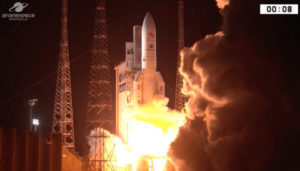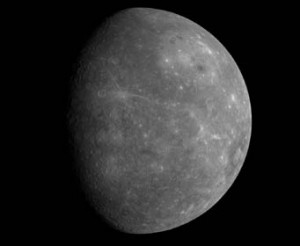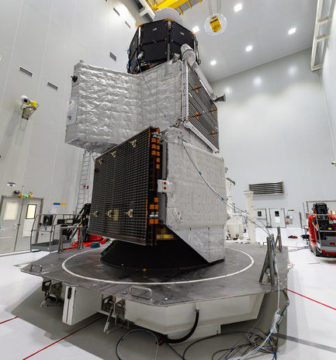The BepiColombo spacecraft, a joint European-Japanese mission to Mercury, rocketed away from Earth to begin its seven-year trek to the innermost planet.

ESA / CNES / Arianespace
We’re going back to Mercury! . . .eventually.
The BepiColombo spacecraft launched October 19th, at 9:45:28 p.m. EDT, atop an Ariane 5 rocket from an equatorial launch site in Kourou, French Guiana, beginning a seven-year journey to Mercury. The voyage began perfectly, atop towering pillars of flame that lit up the early morning sky and remained visible until the side boosters burned out 2 minutes later, leaving the steady light of the main rocket stage visible as a greenish point in the sky.
BepiColombo’s journey will return it to Earth, past Venus twice, and take it by Mercury six times before finally settling in to orbit on December 5th, 2025. The mission is a combined effort of the European Space Agency (ESA) and the Japan Aerospace Exploration Agency (JAXA).
Questions that Need Answering

NASA / APL / Carnegie Institution for Science
Getting to Mercury is difficult — so difficult that fewer spacecraft have visited Mercury than have visited Saturn. NASA has sent two spacecraft: Mariner 10, which completed three flybys (all over the same hemisphere) in 1974 and 1975, and Messenger, which accomplished its orbital mission from 2011 to 2015.
Messenger was one of NASA’s low-cost Discovery missions. It accomplished a lot with its diminutive payload, producing a global photo map as well as more detailed maps of topography and composition in the northern hemisphere. (The spacecraft’s elliptical orbit took it too far from the southern hemisphere for detailed mapping.) Messenger made discoveries about Mercury’s magnetic field and the tenuous cloud of atoms that fly in space around the planet, confirmed the presence of ice at the poles, and identified places with relatively recent geologic activity. But it left us with more new questions than it answered old ones — as any good survey mission should do.
How can the terrestrial planet with the biggest iron core have so little iron in its crust? Why is its core so big? How can its crust have so much sulfur when it’s the closest planet to the Sun? Why is its magnetic field shifted to the north of the planet’s center? Why do some of Mercury’s craters have dark rays, and others bright? What process formed the bizarre Swiss-cheese features called “hollows”?
Two Spacecraft in One

ESA / CNES / Arianespace / S. Martin (Guiana Space Center)
BepiColombo will bring flagship-class science to Mercury to answer questions both old and new. It comprises two science spacecraft. One, the Mercury Planetary Orbiter (MPO), was built by ESA and will operate in a nearly circular orbit close to the planet. The other, Mercury Magnetospheric Orbiter (MMO), was built by JAXA and will fly in a much more elliptical orbit, far from the planet. The two will always be in the same orbit plane, making it easy to do simultaneous observations of the behavior of the magnetic field and particles in different locations near Mercury.
BepiColombo’s science package recapitulates Messenger’s but with sharper and broader vision and the advantage of two spacecraft. Both probes carry magnetometers, to study how Mercury’s internally generated magnetic field responds to buffeting from the active Sun. Both carry instruments to study the planet’s exosphere — the neutral atoms and ions knocked off Mercury’s surface by incoming radiation. MMO also has a dust counter, something Messenger didn’t have.
MPO has cameras and spectrometers to take photos and compositional measurements of the surface. From its nearly circular orbit, MPO will get much closer to Mercury’s surface and obtain much sharper images than Messenger could, placing its observations in context with the benefit of Messenger’s map. MPO will try to understand the composition of Mercury’s crust and the nature of its volcanic activity, and will search for evidence of the timing of Mercury’s shrinking along near-surface faults. Messenger hinted at small-scale faults on which shrinking could be occurring today; MPO will try to determine if the innermost planet is still active. Scientists are particularly interested in seeing Mercury’s south pole up close and in detail for the first time, to find out whether it has reservoirs of ices and organic-rich materials, as the north pole does.
(Article continues after graphic.)
A Long Road Ahead

It’s not easy to get to Mercury. A spacecraft has to shed a huge quantity of angular momentum to get close to the Sun and settle into orbit around the small planet. BepiColombo will be getting a ride from a third spacecraft built by ESA, the Mercury Transfer Module (MTM). MTM will use solar-electric propulsion, its huge solar panels powering ion thrusters that will continuously fire for most of the journey. Shortly before arriving at Mercury, BepiColombo will drop the MTM, thus avoiding the requirement of slowing down into Mercury orbit with all that extra mass.
BepiColombo has a long way to go, but it’s accomplished the most dangerous part of its mission — the launch. Mercury Orbit Insertion in December 2025 should be a piece of cake by comparison. By the time the spacecraft completes its sixth flyby of Mercury in January of that year, it will be traveling slow enough to be captured naturally, by Mercury’s own gravity, the seventh time the planet and spacecraft meet.
Until then, enjoy this replay of the launch (which starts 38 minutes into the clip)!
 2
2









Comments
BobW
October 27, 2018 at 11:12 pm
Nice article! But I do have a question: The image of Mercury near the top has a caption saying it was photographed by Messenger in 2008, but the article says Messenger "accomplished its orbital mission from 2011 to 2015". I know it traveled a complex path getting there, was the image acquired somewhere along the way, before orbiting Mercury?
Thanks,
BobW
You must be logged in to post a comment.
Christopher Crockett
October 29, 2018 at 9:18 am
Good eye. The image was taken on Messenger's first flyby of Mercury, which was in 2008. The spacecraft flew by Mercury THREE times actually, in 2008 and 2009. Each flyby slowed the probe down. It finally settled into orbit in 2011.
You must be logged in to post a comment.
You must be logged in to post a comment.